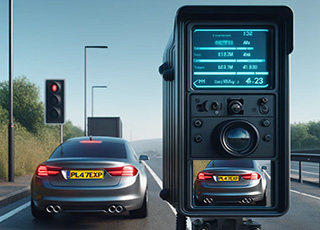We often take our busy roads for granted, assuming we can see everything, but we’re actually under the watchful gaze of the latest technology – Automatic Number Plate Recognition (ANPR) cameras. ANPR systems are now crucial for law enforcement and traffic control, changing how we monitor and use our urban areas and roads.
ANPR, or Automatic Number Plate Recognition, is advanced technology that uses high-res cameras, special software, and OCR algorithms to capture and digitise licence plates for interpretation and cross-referencing. ANPR cameras serve as the digital eyes that never blink, capturing every plate that comes into their view.
In this piece, we will look at the role ANPR cameras play in helping police and traffic management. We’ll explore how this technology also assists in detecting crime, locating stolen vehicles, and monitoring traffic flow. Moreover, we’ll uncover the multitude of benefits ANPR systems bring, from enhancing road safety to improving congestion management.
How ANPR Cameras Work
ANPR cameras rely on a combination of components and sophisticated technology to assist them when operating on our roads..
Components of an ANPR System
High-Resolution Cameras
At the heart of every ANPR camera system is a high-resolution camera. These cameras are equipped with lenses designed to capture clear and detailed images of number plates. The quality of the camera’s optics plays a crucial role in ensuring that plates can be read accurately even under challenging conditions, such as high speeds and varying weather.
Infrared Illuminators
To ensure that ANPR cameras operate effectively in all lighting conditions, including pitch-black darkness, infrared illuminators are employed. These illuminators emit invisible infrared light, making it possible for the camera to capture sharp and legible images, even at night or in poorly lit environments.
Advanced Image-Processing Software
The captured images are only the beginning of the process. To turn these images into useful data, ANPR systems rely on advanced image-processing software. This software contains Optical Character Recognition (OCR) algorithms, which are responsible for extracting the alphanumeric characters from the number plates. The characters are then converted into a digital format that can be understood by the ANPR system.
Image Capture and Processing
The process of ANPR image capture is both swift and intricate. When a vehicle comes into view of an ANPR camera, the high-resolution camera captures an image of its licence plate. Simultaneously, the infrared illuminators ensure that this process works well in low light or no-light conditions.
The captured image is then subjected to OCR analysis. The OCR software carefully examines the image, identifies the characters on the plate, and translates them into digital data. This digital data is then compared with databases to check for matches, potentially revealing important information about the vehicle.
Types of ANPR Cameras
The world of ANPR technology is characterised by diversity, with various types of cameras catering to different needs.
Fixed Cameras
These are stationary cameras placed at specific locations. They’re often used for tasks like monitoring traffic flow, identifying vehicles entering or exiting restricted areas, or collecting tolls.
Mobile Cameras
Mounted on law enforcement vehicles, mobile ANPR cameras provide mobility and flexibility. Law enforcement agencies can use them for tasks like locating stolen vehicles, identifying vehicles of interest, and monitoring traffic violations in real-time.
Latest Advances in ANPR Technology
ANPR technology continues to evolve and improve. The latest advances include cameras with even higher resolution and imaging capabilities. These advancements lead to greater accuracy in capturing and interpreting number plates, making ANPR systems even more effective in law enforcement and traffic management. Moreover, improvements in data analytics and integration with other systems enhance the overall functionality of ANPR technology, enabling it to contribute even more significantly to our roadways’ safety and efficiency.
UK Number Plates and ANPR
Types of Number Plates in the UK
The United Kingdom’s roads are littered with a range of different number plates, and they are all designed for a different purpose.
Standard Plates
These are the most common type of number plates and are issued to the majority of vehicles. They display a combination of letters and numbers, featuring a unique arrangement based on the year of issue.
Personalised Plates
Personalised or private plates allow vehicle owners to choose specific combinations of letters and numbers. This enables them to personalise their vehicles with unique messages or phrases, within certain constraints defined by law.
Green Strip Plates
A special category of plates, these boast a green strip on the left side. This strip signifies an eco-friendly vehicle, one with low carbon dioxide (CO2) emissions. These plates are commonly found on electric and hybrid vehicles.
Legal Requirements for UK Number Plates
UK number plates must adhere to strict legal requirements, ensuring uniformity and readability. The Driver and Vehicle Licensing Agency (DVLA) has laid out regulations to govern these plates. The legal requirements for UK number plates include:
Character Font
All characters on the plate must use the mandatory Charles Wright font. This standardised font ensures legibility and allows ANPR cameras to accurately identify the characters.
Character Size and Spacing
Characters must conform to specific dimensions, ensuring uniformity across all plates. Adequate spacing is crucial to facilitate recognition by ANPR systems.
Reflectivity
Number plates must possess a specific level of reflectivity to remain visible, even in low-light conditions.
Materials
Plates must be made from certain approved materials to guarantee durability and legibility throughout their lifespan.
Green Stripe Design
For vehicles with green stripe plates, the green colour must adhere to precise specifications, and the strip should be positioned on the left side.
How ANPR Cameras Read and Recognise UK Number Plates
ANPR cameras excel in recognising UK number plates by employing Optical Character Recognition (OCR) technology. When a vehicle comes into the camera’s view, it captures an image of the number plate. The OCR software then gets to work, meticulously examining the image to identify and record the characters.
To achieve this, the OCR software uses pattern recognition and context analysis. Pattern recognition allows it to discern the specific shape and design of each character, while context analysis helps decipher the order and meaning of these characters within the plate.
Challenges of Reading and Recognising UK Number Plates
Despite their remarkable capabilities, ANPR cameras face challenges when it comes to UK number plates:
Dimly Lit Conditions
In low-light or nighttime situations, capturing clear images becomes more challenging. ANPR cameras rely on infrared illuminators to assist in capturing legible images in such conditions.
Obstructed or Damaged Plates
Plates that are obscured, damaged, or partially covered can pose difficulties. ANPR cameras may struggle to identify characters that are not clearly visible.
High-Speed Scenarios
In scenarios where vehicles are moving at high speeds, split-second accuracy is crucial. ANPR cameras must capture and interpret number plates swiftly to ensure the system works efficiently.
Despite these challenges, ANPR systems have been meticulously designed and fine-tuned to excel in recognising UK number plates across various conditions, contributing significantly to law enforcement and traffic management efforts.
Law Enforcement Applications of ANPR
When it comes to implementing the law and ensuring people adhere to laws, ANPR cameras play a very important role. They support police across many different areas, enabling them to do their jobs effectively.
These sophisticated cameras have proven their worth through a range of contributions to crime detection, vehicle identification, and suspect tracking. The police leverage ANPR cameras in a multitude of ways:
Crime Deterrence
ANPR cameras act as a deterrent, discouraging potential criminals by creating an omnipresent surveillance net. Knowing that their movements may be tracked and analysed, potential wrongdoers may think twice before engaging in unlawful activities.
Vehicle Identification
One of the primary functions of ANPR cameras is the rapid scanning and identification of vehicle licence plates. These cameras can process a multitude of plates within seconds, allowing law enforcement to instantly identify vehicles involved in crimes or registered as stolen.
Suspect Tracking
ANPR cameras are instrumental in tracking down suspects. If a vehicle associated with a suspect is spotted by an ANPR camera, law enforcement can receive immediate alerts, enabling them to initiate a pursuit or apprehend the suspect without delay.
Cross-Referencing with Databases
Perhaps one of the most potent capabilities of ANPR systems is their ability to cross-reference captured plate data with extensive law enforcement databases. These databases contain a wealth of information, including criminal records, vehicle ownership details, and more. Such cross-referencing can reveal connections, unearth potential suspects, and aid in investigations.
Detecting and Preventing Crime
ANPR cameras serve as active crime detectors and prevention tools. By scanning and identifying licence plates in real time, these cameras can instantly flag vehicles associated with criminal activity, stolen cars, or suspects with outstanding warrants. This rapid detection enables Police to take immediate action, such as stopping a stolen vehicle or apprehending a suspect before they can escape.
ANPR systems support police in many different ways, making it possible to carry out their duties and their reach in ways that were never once possible. They can now monitor roads and areas across whole cities and counties from one central hub.
Role in Solving Major Crimes
ANPR systems have played pivotal roles in solving major crimes. These cameras supply critical data that helps investigators piece together timelines, track the movements of individuals, and establish connections in complex criminal cases.
Traffic Management Applications of ANPR
While ANPR technology remains a significant part of what the police do, its capabilities extend far beyond police work, benefitting traffic management agencies. These agencies have harnessed the power of ANPR cameras to effectively monitor and manage traffic flow. This allows them to keep drivers, news outlets and other channels informed of traffic issues and problems, helping to keep our roads moving.
Diverse Use by Traffic Management Agencies
Traffic management agencies employ ANPR cameras in a myriad of ways, each contributing to the overall enhancement of traffic management:
Traffic Flow Monitoring
ANPR cameras continuously track and record the movements of vehicles on the road. The real-time data collected by these cameras offers crucial insights into traffic flow, congestion patterns, and travel times.
Congestion Reduction
Armed with data collected by ANPR cameras, traffic management agencies can take strategic measures to reduce congestion. By identifying bottlenecks and optimising traffic signal timings, agencies can ease traffic congestion, thereby enhancing the daily commute for countless drivers.
Enhancing Road Safety
ANPR cameras play a vital role in road safety. By monitoring and recording vehicle movements, they provide valuable data that can be used to identify accident-prone areas, improve signage, and optimise road layouts for safer travel.
The Future of ANPR
The future of Automatic Number Plate Recognition (ANPR) technology is filled with potential and exciting possibilities, particularly when it comes to enforcement and traffic management. As ANPR technology continues to evolve, it promises a brighter, more efficient, and safer future for our roads and communities.
The Predictions for the Future
The trajectory of ANPR technology points towards a future that is marked by innovation, accessibility, and a wider range of applications. Here are some predictions for what lies ahead:
More Widespread Use of ANPR Cameras
ANPR cameras are on an ascending trend, becoming increasingly affordable and accessible. Their use is now being seen across rural areas and major cities, bringing together these areas while ensuring they are covered and protected. This enables the Police and traffic management agencies to collect more data and enhance their monitoring capabilities.
More Sophisticated ANPR Technology
ANPR cameras are undergoing constant refinement, resulting in greater sophistication and accuracy. They can now read and recognise number plates under various challenging conditions, such as low light, adverse weather, and high-speed scenarios. This heightened accuracy equips ANPR systems to be even more effective in detecting and preventing crime and optimising traffic flow.
Integration with Other Technologies
ANPR systems are progressively integrating with other advanced technologies, including facial recognition and artificial intelligence. This integration paves the way for greater automation and enhanced decision-making abilities for law enforcement and traffic management agencies.
Exploring Future Possibilities
The future of ANPR holds a plethora of opportunities for its application:
Tracking Suspects and Vehicles of Interest
ANPR technology can be employed for tracking suspects and vehicles of interest, streamlining law enforcement’s crime-solving capabilities. By swiftly identifying and monitoring these subjects, law enforcement agencies can significantly expedite investigations and enhance public safety.
Traffic Flow Monitoring and Congestion Identification
ANPR cameras have the potential to play a more significant role in monitoring traffic flow and identifying congestion hotspots. This data will empower traffic management agencies to develop more effective strategies for traffic management, reducing congestion and improving overall road safety.
Parking Violation Enforcement
ANPR technology can be harnessed for identifying and enforcing parking violations with precision. This initiative will not only alleviate congestion but also contribute to improving road safety and enhancing the overall driving experience.
Access Control for Restricted Areas
ANPR systems can manage access to restricted areas, bolstering security at sensitive locations like airports and government buildings. The integration of ANPR with access control measures will enhance security protocols, ensuring that only authorised individuals gain entry.
The future of ANPR technology is a promising one. As it gets more advanced, affordable, and works with other tech, ANPR is set to be a key player in law enforcement and traffic management, making our communities safer, roads more efficient, and daily lives easier.
Finally
ANPR has now become an integral part of country-wide monitoring of our roads and other areas. Through their seamless interaction with UK number plates, they bolster safety, detect crime, and keep traffic flowing smoothly. As we move forward, the next chapter in ANPR technology promises greater precision and innovation, transforming the way we use our roads, making them safer and reducing crime rates..



